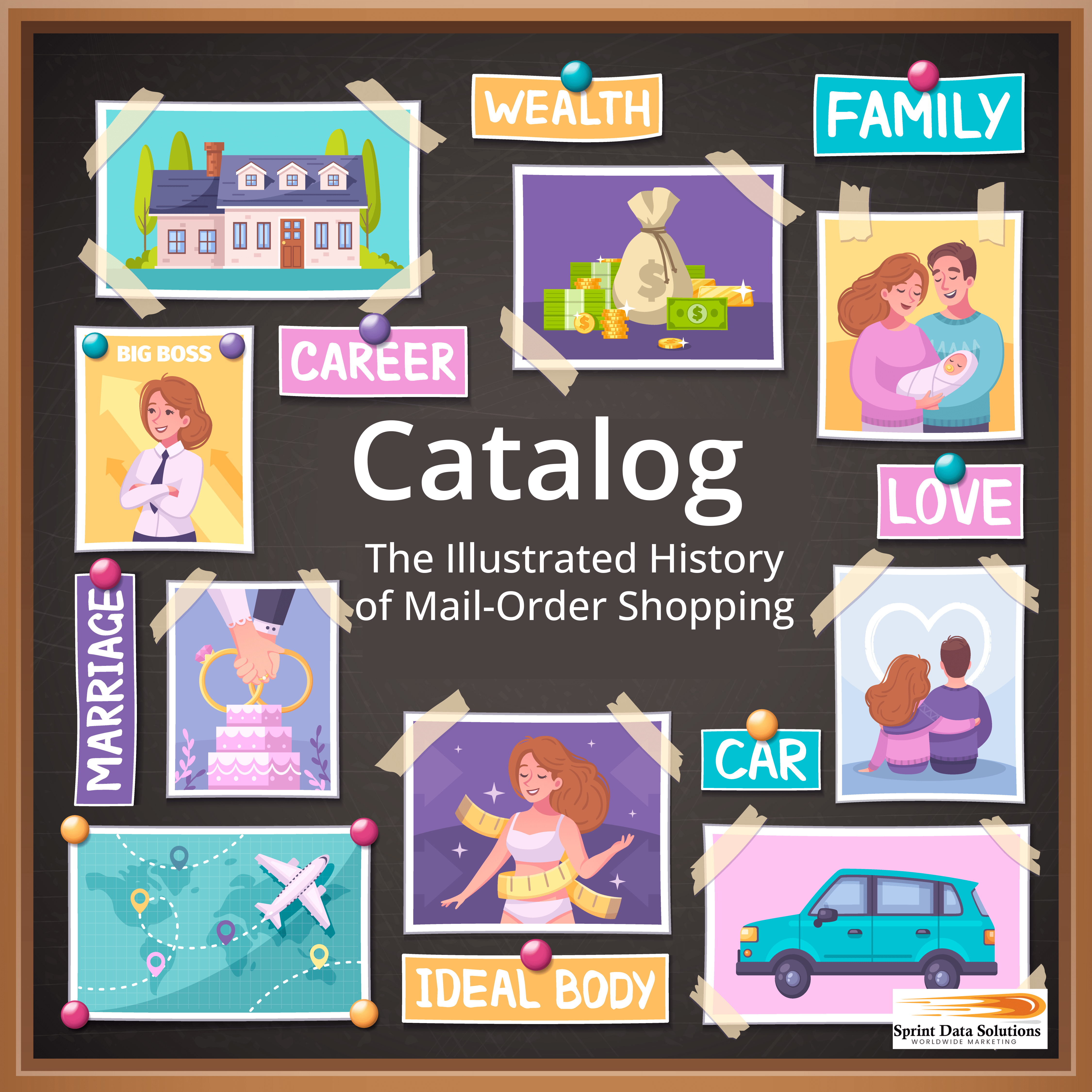Catalog & Magazine Mailing List
The 21st century has brought about profound transformations in how we engage with traditional activities. One of the most notable shifts has been in the way Americans shop. In past generations, shopping was a communal and physical activity, often involving trips to markets, stores, or malls to purchase goods. Today, however, digital shopping has revolutionized the retail experience. Thanks to the rise of e-commerce, Americans can now purchase almost anything from the comfort of their homes, using websites or mobile apps. Despite this, traditional methods of marketing, like catalogs, still play a significant role in the consumer landscape, bridging the old and new.
Catalogs, which once represented the pinnacle of print-based marketing, continue to hold relevance in the digital era. They evoke a sense of nostalgia for many while serving as a practical tool for consumers seeking to browse products outside the confines of a website. Catalogs and their print counterparts, like flyers, remain a valuable method for marketers to display product information, often alongside enticing discounts or exclusive offers. In fact, catalogs have directly influenced the way modern e-commerce platforms are structured, with product categories, detailed descriptions, and organized sections that echo the layout of traditional print materials.
Even in today’s digital-first world, the integration of catalogs with other forms of media, such as magazines, provides an essential touchpoint for reaching specific audiences. Many consumers still find comfort in flipping through a catalog or receiving one in the mail, making it a powerful tool for brands to keep their products in front of potential buyers. Sprint Data Solutions Worldwide Marketing understands the importance of both digital and traditional marketing strategies. With expertise in providing businesses access to targeted consumer databases, they offer tailored solutions to effectively reach audiences that engage with catalogs, magazines, and other print media. This combined approach helps businesses reach new customers, while maintaining strong connections with loyal ones.
The Sprint Data Solutions Worldwide Marketing Story
Sprint Data Solutions Worldwide Marketing is a proud, 100% American-owned business, founded by a disabled veteran with a vision to create a positive economic impact. After fulfilling the duties of serving the country, the founder recognized the importance of transitioning from defense-focused work to economic growth. The goal was to build a business that would contribute to the prosperity of the American business community, not only through defense but by fostering economic development and innovation. This vision led to the creation of Sprint Data Solutions Worldwide Marketing, a company based in Las Vegas, Nevada, designed to support businesses in expanding their customer bases.
Over the years, Sprint Data Solutions Worldwide Marketing has seen substantial growth, successfully adapting to the changing landscape of marketing and technology. The company has built a reputation for excellence and reliability, with a loyal client base and a staff boasting more than 50 years of combined experience in the marketing and sales sectors. Their expertise spans across a variety of disciplines, from traditional direct mail marketing to cutting-edge digital marketing solutions. The company’s leadership remains committed to ensuring the success of its clients, continuously innovating and adapting to new challenges. Today, Sprint Data Solutions Worldwide Marketing stands as a testament to the founder’s vision, with a deep-rooted dedication to growing American businesses and contributing to the economy.
When Sprint Data Solutions Worldwide Marketing first began its operations, the marketing landscape was still deeply entrenched in traditional methods. The dominant platforms of the time were print and television advertising, which shaped the strategies businesses used to reach their audiences. Recognizing the enduring power of print marketing, Sprint Data Solutions initially focused on direct mail, which at the time was one of the most effective ways to connect with potential customers. Over the years, direct mail has remained a cornerstone of the company’s success, and it continues to play a significant role in its offerings today.
As the business grew, so did its ambitions. Starting from its base in Las Vegas, Nevada, Sprint Data Solutions expanded its services to cover not just the state, but the entire continental United States, including remote states like Hawaii and Alaska. This growth was driven by the increasing demand for direct mail services that could reach diverse customer bases across vast geographic areas. The company didn’t stop there; recognizing the need for broader coverage, it eventually extended its operations to include North America, offering services to clients in Canada and Mexico. Sprint Data Solutions’ international footprint grew even further, with offerings tailored to European Union markets, such as France, providing businesses with the opportunity to reach global audiences through effective direct mail campaigns.
However, the company’s journey didn’t end with the expansion of direct mail services. As the digital landscape evolved, Sprint Data Solutions embraced new technologies and began integrating digital marketing services into its portfolio. The rise of internet-based marketing and the increasing reliance on digital communication channels presented new opportunities for the company to serve the expanding needs of businesses that wanted to reach consumers online. With the growing importance of email marketing, social media campaigns, and other digital strategies, Sprint Data Solutions adapted to meet these demands. Today, the company offers a comprehensive range of marketing solutions, blending traditional direct mail with modern digital services to deliver innovative, multi-channel campaigns that help businesses connect with their audiences in the most effective ways possible.

The Catalog & Magazine Advantage
Although the rise of digital technology has transformed the way we shop and consume content, physical catalogs and magazines continue to retain their charm and effectiveness, offering unique advantages that digital media often cannot match. Despite the shift toward online shopping, catalogs are far from obsolete. In fact, they have evolved to complement modern shopping trends. With the ability to browse products from the comfort of one’s home, customers can now receive catalogs tailored to their preferences, making it easier to shop in a tangible way. While online stores offer immediate transactions, catalogs still provide a slower, more deliberate shopping experience that allows consumers to peruse offerings at their own pace, without the urgency of digital interfaces.
The same can be said for magazines, which still serve as a powerful medium for capturing attention and conveying rich, visually engaging content. A well-curated magazine, created with expert editorial and design skills, often boasts a level of quality that digital platforms struggle to replicate. The tactile experience of flipping through a magazine can create a stronger emotional connection with readers, offering them an experience that is immersive and memorable. Unlike websites that rely on fast-loading pages and digital screens, magazines provide a break from the digital noise, offering a sensory experience that is sometimes more enjoyable and focused.
Both catalogs and magazines bypass the saturated digital spaces where email inboxes are overflowing, providing businesses with a rare opportunity to make a lasting impression. By engaging consumers with carefully crafted print materials, businesses can cut through the clutter of online advertising and deliver a more impactful, physical reminder of their offerings. Furthermore, once customers are ready to act on their interest, they can easily transition to making an order via phone, website, or mobile app. This seamless integration between the physical and digital worlds ensures that catalogs and magazines continue to play a valuable role in modern marketing strategies. This can be useful for businesses such as:
Home Cooking Magazines
The COVID-19 pandemic had a profound effect on many aspects of daily life, including dining habits. As restaurants were forced to close or operate under strict restrictions, people began to view home-cooked meals as not only a safer option but also a more cost-effective alternative to dining out regularly. Even as the pandemic subsides and restrictions ease, many consumers continue to prioritize cooking at home, embracing it as a way to save money while enjoying the comfort of homemade meals. This shift in behavior has led to an increase in interest around home cooking, as more individuals seek ways to recreate restaurant-quality dishes from the comfort of their kitchens.
Cooking magazines have become an invaluable resource during this time, offering both tried-and-true recipes and innovative new ideas for home cooks. Unlike digital devices such as smartphones and tablets, which can become cluttered with notifications or easily interrupted by calls or messages, printed magazines provide a hands-on, distraction-free cooking experience. They offer a more tangible, reliable format that allows readers to easily follow recipes without the worry of a phone screen freezing, battery life draining, or messy screens from ingredients. Moreover, many cooking magazines feature beautifully curated collections of recipes, tips, and culinary inspiration, making them a great addition to any kitchen. As the preference for cooking at home continues, these magazines provide a trusted and enjoyable resource for anyone looking to enhance their culinary skills while sticking to their monthly budget.
Fine Wines
Wine is not just a beverage; for many, it represents a passion, a hobby, and even a valuable investment opportunity. Whether enjoyed casually or with great expertise, wine is deeply ingrained in cultures around the world, symbolizing sophistication and refinement. As a result, the marketing of wine has evolved into a nuanced field that caters to a wide variety of consumer preferences, ranging from enthusiasts to connoisseurs. Wine-focused publications such as magazines and catalogs continue to hold significant appeal for wine lovers, who appreciate in-depth knowledge, history, and culture surrounding their favorite drink.
For wine brands and marketers, understanding the diverse market is essential. Wine is marketed across various price points, with options ranging from affordable, everyday table wines to premium bottles sourced from award-winning vineyards. The luxury segment, featuring rare wines like vintage ports or ice wines, offers opportunities for exclusive campaigns aimed at discerning consumers looking to mark special occasions. Marketing at this level often involves highlighting the heritage of the winery, the craftsmanship behind each bottle, and the wine’s potential as an investment asset.
In addition to showcasing the wines themselves, effective wine marketing also involves educating consumers about the intricate aspects of wine culture. Wine magazines, in particular, play a key role in this regard. They serve not only as guides to new wine trends but also as platforms for sharing insights on viticulture, winemaking techniques, food pairings, and the evolving global wine industry. As wine lovers become more knowledgeable, the demand for quality content grows—consumers want to learn about the latest wine trends, discover hidden gems, and deepen their understanding of what makes each wine unique. Whether through historical education, industry news, or trendspotting, wine magazines and catalogs continue to be an essential part of this ongoing conversation.

Cigars
Much like wine, cigars are often seen as a luxury, indulgent product associated with celebration, relaxation, and refinement. Over centuries, cigars have evolved from a rare commodity to a symbol of sophistication and craftsmanship, with enthusiasts cherishing the rich history and tradition behind each brand. Although cigars are generally considered an acquired taste, their appeal remains strong, with aficionados appreciating the unique flavors, textures, and aromas they offer. This passion for cigars persists despite the contemporary health warnings and regulations that surround them.
Unlike cigarettes, which are consumed more frequently, cigars are typically enjoyed on special occasions or during moments of relaxation, making them a less frequent indulgence. This slow consumption pattern contributes to a market where customers often seek to replenish their stock over time. However, the appeal of cigars goes beyond simple consumption—similar to wine, there’s a culture of experimentation and discovery. Cigar lovers often take pleasure in trying new blends, exploring different sizes and shapes, and comparing the distinctive characteristics of various tobacco leaves.
To succeed in the cigar industry, effective marketing is crucial. Much like wine marketing, cigars benefit from a focus on presentation, the quality of ingredients, and the unique aspects of each product. High-quality marketing materials that educate and inform consumers about the different varieties, production methods, and flavor profiles can enhance the experience for potential customers. By targeting the right market with compelling stories and detailed information about the craftsmanship behind each cigar, businesses can increase brand loyalty, boost sales, and create an immersive experience that resonates with connoisseurs and casual smokers alike.
Household Goods
Homes are complex spaces that require a wide array of products and services to function efficiently and maintain comfort. From everyday essentials like dishwashing soap and toilet paper to specialized items such as salt for sidewalks during the winter or air filters for HVAC systems, there is an extensive range of products needed across various rooms. Each room of a house has its own unique set of requirements—whether it’s cleaning supplies for the kitchen, toiletries for the bathroom, or maintenance items for the garage and outdoor spaces. The diversity of these products highlights the importance of having access to comprehensive resources to manage a home effectively.
Catalogs play a crucial role in helping homeowners find everything they need in one convenient place. They provide a well-organized collection of products, from household cleaning agents to seasonal necessities, making it easy for consumers to compare options and make informed purchasing decisions. In addition to products, catalogs may also include services like home repairs, appliance maintenance, and renovation recommendations, allowing homeowners to keep their homes in top condition.
Magazines, on the other hand, offer in-depth insight into the latest trends, the best techniques for home improvement, and expert advice on maintaining a household. They often provide reviews of top-rated products, helping consumers navigate the overwhelming array of options available. Whether it’s tips for cleaning, decorating, or organizing, magazines help homeowners make their spaces more functional, beautiful, and comfortable, offering ideas that go beyond simple product recommendations. Together, catalogs and magazines are invaluable tools for homeowners looking to optimize every aspect of their living spaces.
Children’s Products
The market for children’s products has long been vast and dynamic, encompassing a wide array of categories from educational resources and toys to health, nutrition, and entertainment. This broad market presents abundant opportunities for businesses to target parents and caregivers who are constantly seeking the best for their children. Catalogs dedicated to children’s products reflect this diversity, offering everything from learning tools and developmental aids to fun and recreational items.
Among the most effective marketing strategies for reaching this audience are children’s magazines, which serve as a powerful medium to connect brands with parents. These magazines have a unique advantage, as they combine engaging content with advertising that speaks directly to the needs and desires of modern parents. With busy schedules and a never-ending search for products that enhance their children’s lives, parents are highly responsive to well-curated ideas that promote convenience, creativity, and developmental benefits.
Children’s magazines cater to this receptive audience by providing a platform for brands to showcase their offerings in a way that feels natural and engaging. Parents are more likely to trust and explore products recommended in trusted publications, especially when they are presented alongside informative articles and expert advice on parenting and child development. Whether it’s through toy recommendations, educational materials, or health tips, children’s magazines offer businesses a direct line to a highly engaged and motivated audience, making them an invaluable asset in any marketing strategy focused on the family market.
CBD Oil & CBD Creams
As the legal landscape of cannabis continues to evolve across the United States, CBD (cannabidiol), a non-intoxicating compound derived from cannabis, has rapidly gained recognition for its potential therapeutic benefits. Known for its ability to alleviate stress, reduce pain, and support digestive health, CBD oil has found widespread use among both humans and animals. Unlike THC, the psychoactive component of cannabis, CBD does not produce a “high,” which makes it suitable for a broad range of consumers seeking relief without intoxication.
The versatility of CBD oil makes it an ideal product for targeted marketing across various channels, particularly in magazines and catalogs that cater to specific needs. From relieving chronic pain to helping manage anxiety, CBD oil appeals to a diverse audience with different preferences and requirements. This product has become especially popular among seniors, many of whom use CBD oil as a natural alternative for pain management and improved mobility. Seniors, dealing with conditions such as arthritis and general discomfort, have embraced CBD for its non-intoxicating properties and minimal side effects, making it an attractive option in their wellness routines.
In contrast, athletes and active individuals often turn to topical CBD creams to address muscle soreness and enhance recovery after workouts. The needs of these two groups—seniors and athletes—are distinctly different, and marketing CBD-based products requires a nuanced approach to address their specific concerns and preferences. While seniors may focus on the pain-relief and anti-inflammatory properties of CBD, athletes may be more interested in its ability to support muscle recovery and reduce post-exercise discomfort.
By understanding these varying customer needs, businesses can effectively tailor their marketing efforts to reach the right audience, promoting CBD products through targeted messaging that resonates with each demographic. Whether for pain relief, stress management, or muscle recovery, CBD oil presents a wide array of applications that can be best served through strategic and targeted marketing campaigns.
Sports Magazines & Products
Sports magazines have long been a cornerstone of sports culture, offering enthusiasts in-depth coverage on athletes, teams, events, and the latest developments in the world of sports. For decades, publications have catered to a wide range of interests, from mainstream sports like basketball and football to more specialized areas such as bobsledding or even niche disciplines like curling. This enduring demand for comprehensive, insider information reflects the ongoing desire of fans to stay connected with their favorite sports and athletes, no matter the scale or popularity of the sport.
The demand for sporting products is equally robust. Whether it’s cutting-edge gear for professional athletes or casual sports equipment for hobbyists, the market for sporting products remains ever-present. Magazines dedicated to sporting goods play a crucial role in this ecosystem, offering detailed product catalogs and reviews that help consumers make informed purchasing decisions. These publications provide insights on the latest advancements in technology, product design, and performance, and can effectively connect companies with sports enthusiasts who are always seeking the next great product for their respective activities.
To effectively engage this diverse audience, it’s essential to align the right products with the right publications and target sports enthusiasts who are most likely to appreciate the specific offerings. With so many varied interests within the sports world, whether it’s top-tier athletes or weekend warriors, businesses that curate well-targeted product selections and pair them with the appropriate magazine outlets can capture the attention of highly engaged audiences. The key to success lies in understanding the unique needs of each sport’s community and delivering products that enhance their experience.
Seeds & Plants
Gardening has long been a cherished activity in American homes, providing not only an outlet for creativity but also a way to cultivate a more sustainable lifestyle. Recently, there has been a resurgence in the popularity of gardening, driven by a heightened focus on environmental sustainability, healthier living, and the financial benefits of growing one’s own food. As consumers become increasingly aware of the environmental impact of mass-produced food and the importance of supporting local ecosystems, more individuals are turning to their gardens to produce everything from fresh herbs and vegetables to decorative flowers and plants.
The growing interest in home gardening opens up numerous opportunities for businesses to cater to a wide range of gardeners, whether they are beginners taking their first steps into the world of horticulture or seasoned gardening enthusiasts looking for more specialized products and techniques. For novices, there is a growing demand for basic gardening tools, seed kits, easy-to-follow gardening guides, and beginner-friendly plants that can thrive in a variety of climates. These items are ideal for individuals seeking to embrace gardening as a hobby, especially those who have recently discovered the therapeutic and rewarding aspects of growing their own food.
For more experienced gardeners, the market offers an array of advanced products, such as high-quality organic seeds, innovative planting systems, advanced soil amendments, and tools that help optimize garden productivity. These consumers may also be interested in specialized services like landscape design, sustainable farming practices, and advice on rare or exotic plants. As gardening continues to evolve with new trends, including urban farming and vertical gardening, businesses can further tap into this demand by offering eco-friendly products that appeal to environmentally conscious consumers and those looking to reduce their carbon footprints. Whether addressing the needs of first-time gardeners or catering to seasoned experts, the gardening industry has the potential to thrive in a market focused on sustainability and self-sufficiency.
Collectibles
A significant and highly engaged segment of the consumer demographic is passionate about collectibles, but their interests are far from uniform. Collectors often focus on specific niches, with purchasing behaviors and preferences varying dramatically based on the type of collectible. For example, a stamp collector’s interests will be centered around the artistry, history, and rarity of individual stamps, while a vinyl enthusiast is drawn to both new releases and vintage music pressings, valuing the audio quality, album artwork, and the thrill of finding limited editions. Similarly, retro gamers, who focus on old video game hardware and software from the 1980s and 1990s, have completely different interests, prioritizing the nostalgia and historical significance of the gaming systems and rare titles.
This diversity underscores the importance of specificity when marketing to these groups. For example, a catalog dedicated to stamp collecting will not capture the attention of a retro gamer, nor will a vinyl-focused magazine be effective for someone interested in retro gaming. In fact, if marketed incorrectly, such materials may fail to generate any response from these distinct groups. On the other hand, when tailored marketing efforts reach the right collector with the right material, the response is often overwhelming. A carefully curated catalog of rare vinyl pressings or a specialized magazine about retro gaming can spark intense interest, foster engagement, and prompt purchases from collectors who are eager to expand their collections.
The key to success in the collectibles market lies in understanding the unique motivations and preferences of each group and presenting them with content that speaks directly to their passions. By doing so, businesses can not only drive engagement but also establish a loyal customer base in these specialized, highly enthusiastic markets.

Clothing & Fashion
Clothing continues to be a prominent category in the retail industry, with a long-standing presence in catalog offerings. This trend has not only endured but has also evolved alongside the rise of online shopping. Today, clothing remains a key component of both traditional mail-order catalogs and e-commerce sales, driving a substantial share of consumer purchases. Sprint Data Catalog Mail Order buyers and RESPONDERS, who have shown an affinity for shopping, recognize the enduring popularity of fashion and apparel. However, the types of clothing purchased can vary significantly depending on the specific preferences, needs, and lifestyles of customers.
For many consumers, clothing serves a functional role, especially in professional or workwear categories. In these cases, durability, protection, and comfort often take precedence over purely aesthetic qualities. For instance, high-quality materials that withstand the wear and tear of a busy workday are frequently prioritized by individuals in industries like construction, healthcare, or manufacturing. On the other hand, fashion-forward clothing continues to thrive among those with an eye for style, and brands targeting these segments must keep up with changing trends and seasonal shifts.
What consistently proves essential in the success of clothing catalogs and magazine advertisements is high-quality imagery. The visual appeal of clothing is a critical factor in driving consumer interest, and brands that invest in top-tier photography typically see a higher return on their marketing efforts. Whether showcasing the latest fashion trends or practical, everyday attire, captivating images that highlight the garment’s details, fit, and versatility can greatly influence purchasing decisions. When combined with compelling content that explains the unique benefits and features of each item—whether that’s style tips or practical insights into the clothing’s utility—brands can establish a strong emotional connection with their audience, making clothing an evergreen staple in catalog and magazine sales.
Home Improvement
While partnering with experienced professionals often leads to high-quality home improvement and renovation outcomes, it also represents a considerable financial commitment. This is one of the reasons why “Do It Yourself” (DIY) home improvement continues to be a favored choice for many homeowners. DIY projects allow homeowners to take charge of their renovations and repairs, offering a sense of accomplishment and the potential to save on labor costs. For businesses offering home improvement products and services, this trend presents a valuable opportunity to connect directly with consumers, driving significant revenue when the right marketing strategies are employed.
Homeowners frequently identify projects in need of repair or improvement, whether it’s something as simple as repainting a room or as ambitious as completely remodeling a kitchen or adding additional living space. These improvements, when executed correctly, can not only enhance the functionality and aesthetic appeal of a home but also add considerable value to the property. The home improvement industry is diverse, encompassing everything from plumbing and electrical upgrades to flooring installations, foundation repairs, and full-scale renovations. Given its wide-ranging nature, this sector presents numerous opportunities for businesses to market products, services, and expertise to homeowners at various stages of their improvement journey.
Effective marketing in the home improvement sector requires targeting the right consumer base, whether those interested in DIY supplies, expert guidance, or full-service renovation work. As more homeowners look for ways to enhance their homes, the demand for home improvement-related products and services is growing, making this a highly competitive yet lucrative industry. By leveraging tailored marketing campaigns, businesses can reach consumers who are eager to invest in improving their living spaces, whether through professional services or with DIY solutions.
Precision Marketing
The key to success in traditional print marketing—whether through catalogs, magazines, or other printed materials—lies in setting realistic expectations for response rates. It’s important to recognize that while an appealing marketing campaign can capture attention, achieving a 100% response rate is simply not feasible. However, businesses can take specific steps to maximize the likelihood of a positive response and avoid their materials being overlooked or discarded.
A scattershot approach, where businesses send large volumes of catalogs or marketing materials to a broad audience, is rarely effective in achieving high response rates. For example, purchasing a mailing list with hundreds of thousands of addresses and mailing catalogs to all of them guarantees a flood of deliveries, but it doesn’t ensure that the recipients are interested in the products. If a catalog offers children’s toys, but a significant portion of the recipients are young, single individuals with no children—like college students—this will result in a disappointingly low response rate. The mismatched target audience simply isn’t in need of the product being offered, which means most recipients will ignore the marketing.
In contrast, a more focused, targeted approach yields far better results. For example, if the same catalog is sent only to households with children aged 2-10, even if the list contains only a fraction of the names (say, 20,000 recipients), the likelihood of engagement increases dramatically. These recipients are far more likely to find value in the catalog and respond positively to the offer, as it aligns directly with their interests and needs.
By narrowing the focus and targeting a highly relevant audience, businesses can achieve higher engagement and better response rates, even if it means reaching fewer people overall. This approach may seem counter-intuitive, especially when compared to the idea of marketing to a larger pool of people, but precision often outweighs mass outreach. Marketing to a smaller, more qualified audience with a higher level of interest produces stronger results, fostering greater engagement, increasing sales, and ensuring that marketing dollars are spent wisely. It’s about quality over quantity—precise targeting generates the highest return on investment.
We’re Here To Help
Over the years, Sprint Data Solutions Worldwide Marketing has established itself as a leader in the data management and marketing services industry, accumulating and maintaining an expansive collection of both consumer and B2B databases. What sets the company apart is its commitment to keeping these databases continuously updated, ensuring that they remain accurate, relevant, and free from inefficiencies. This proactive approach prevents issues such as sending marketing materials to outdated or irrelevant contacts—whether that be to individuals who have passed away or to specialized enthusiasts no longer residing at a particular address.
As the marketing landscape continues to evolve, Sprint Data Solutions Worldwide Marketing has adapted to meet the growing demands of modern communication. Today, businesses have far more options than ever before when it comes to reaching their target audiences. It’s no longer sufficient to rely solely on traditional physical mailing addresses. The company has embraced the expanded range of contact points that businesses now require to effectively engage their customers. This includes a variety of channels, such as telephone numbers for voice-based outreach, email addresses for targeted digital campaigns, and mobile numbers for text/SMS messaging, all of which enable businesses to tailor their marketing strategies to the preferences and behaviors of individual consumers.
In an era where consumer expectations are higher than ever and companies need to engage potential customers across multiple platforms, Sprint Data Solutions Worldwide Marketing is at the forefront of providing the most up-to-date and comprehensive contact lists. Their ability to maintain accuracy and adapt to changing communication channels ensures that clients can effectively connect with their target audiences, maximizing marketing efforts and delivering results.
Find The Right List For You
At Sprint Data Solutions Worldwide Marketing, we provide businesses with precisely the data they need to effectively target catalog and magazine buyers, catalog shoppers, and mail-order buyers. Our comprehensive mailing lists are meticulously categorized to meet both consumer and B2B marketing needs, with clear and detailed segmentation to help you reach the right audience. Whether you’re targeting a broad nationwide market or focusing on specific niches, we have the capability to deliver.
Our data is highly customizable, allowing businesses to scale their marketing efforts as needed. Companies can target customers across the entire United States, hone in on a regional audience, or focus on specific states, cities, or even neighborhoods. This flexibility makes it easy to implement hyper-targeted campaigns that are more likely to resonate with your audience. For businesses with a more localized focus, Sprint Data Solutions makes it possible to target only the catalog buyers in a specific area, like New England, or even as granular as a single city or town. This level of specificity ensures your marketing efforts are aligned with your geographic objectives.
Moreover, our databases include highly detailed demographic information based on a wide array of characteristics. We gather and organize key profile data that allows businesses to target customers with precision. These profiles are not just based on broad assumptions but are continuously updated and reviewed to ensure their relevance. Our data is maintained to remain fresh and useful, guaranteeing that the contact details we provide still match the current behaviors and preferences of potential customers. Sprint Data Solutions Worldwide Marketing takes great care to provide databases that are not only accurate but also reflect a wide spectrum of demographics, enabling you to tailor your outreach based on various lifestyle, purchasing habits, and other key attributes that matter most to your business goals.
- Age
- Ethnicity
- Debt
- Age of Children
- Renter
- Homeowner
- Income
- Marital Status
- Mortgage Data
- Geography
- Veteran Status
- Big & Tall Mail Order Buyers
With an extensive selection of data options, Sprint Data Solutions Worldwide Marketing offers the flexibility to target any audience with precision, whether you’re aiming for a broad reach or a highly specific demographic. Our vast range of customizable lists ensures that businesses can connect with the right consumers, based on factors such as purchasing behavior, geographic location, and personal preferences. This flexibility is crucial for creating marketing campaigns that resonate deeply with the intended audience.
For businesses looking to distribute catalogs and magazines effectively, Sprint Data Solutions Worldwide Marketing provides top-tier direct mail lists tailored to maximize response rates. By using our meticulously curated data, you can ensure that your catalogs and magazines reach individuals who are most likely to engage with your content and make a purchase. Whether you’re promoting a new product line or building brand awareness, our services help businesses achieve measurable success.
Let Sprint Data Solutions Worldwide Marketing be your trusted partner in connecting with responsive customers. With our expertly designed catalog and magazine direct mail lists, we empower your campaigns to reach their full potential, ensuring your marketing materials make a lasting impact on the right people at the right time.






